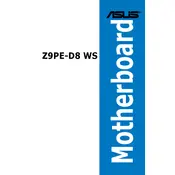ASUS Z9PE-D8 WS User Manual


To install RAM on the ASUS Z9PE-D8 WS motherboard, locate the DIMM slots and ensure the notches on the RAM stick align with the slot. Insert the RAM at a 45-degree angle and press down until the clips snap into place. Make sure to populate Slot A1 first for single-channel operation.
If the motherboard does not power on, first check the power connections, ensuring the 24-pin and 8-pin ATX power connectors are securely attached. Verify that the power supply is functional and that the power switch on the case is connected to the correct pins on the motherboard.
To update the BIOS, download the latest BIOS file from the ASUS support website. Save it to a USB drive formatted in FAT32. Enter the BIOS setup by pressing Del during boot, navigate to the EZ Flash utility, and follow the prompts to update using the file on the USB drive.
The ASUS Z9PE-D8 WS motherboard supports up to 256GB of DDR3 RAM across its 8 DIMM slots, with a maximum of 32GB per slot when using registered ECC memory.
To troubleshoot a no-display issue, ensure the graphics card is seated properly and that the monitor is connected to the correct output. Check the BIOS settings to confirm the primary display adapter is set correctly. Test with a different monitor or cable if possible.
Yes, the ASUS Z9PE-D8 WS supports multiple GPUs for parallel processing. It has seven PCIe slots and supports NVIDIA SLI and AMD CrossFireX technologies, allowing the installation of multiple graphics cards.
The ASUS Z9PE-D8 WS motherboard supports Intel Xeon E5-2600 and E5-2600 v2 series processors, utilizing the LGA 2011 socket. Ensure that the CPU is compatible with the motherboard's chipset.
To set up RAID, enter the BIOS setup and configure the SATA mode to RAID. Reboot and enter the RAID configuration utility by pressing Ctrl+I during boot. Follow the on-screen instructions to create and manage RAID arrays.
The ASUS Z9PE-D8 WS features seven PCIe slots: four PCIe 3.0/2.0 x16 slots (x16 or x8 mode), and three PCIe 2.0 x16 slots (x8 mode). The configuration supports various expansion cards, including GPUs and network cards.
To reset the CMOS, power off the system and unplug it. Locate the CMOS jumper on the motherboard, move it from the default 1-2 position to 2-3 for about 10 seconds, then move it back. Alternatively, remove the CMOS battery for a few minutes and then reinstall it.